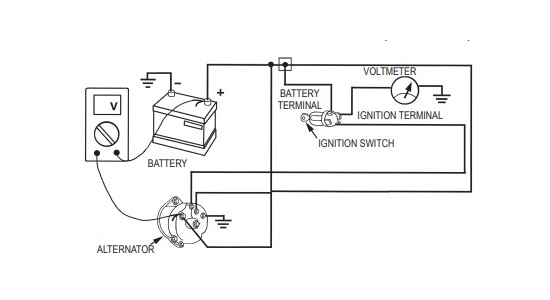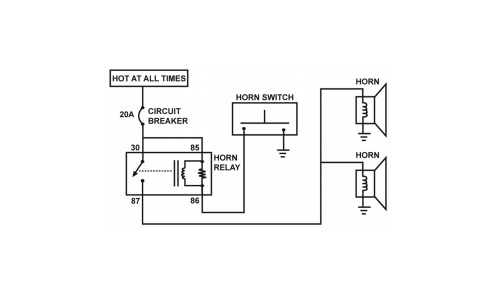Mastering automotive electrical and electronic systems is crucial for any proficient mechanic. Our ASE A6 Electrical/Electronic Systems Practice Test is designed to assess your knowledge of common electrical repair and maintenance procedures.
Results
You are a Champion.
Correct answers:
1. Charging circuit voltage drop
2. A only
3. An open circuit in the driver’s side master control switch
4. Point X and the negative probe to ground
5. A only
6. Both A and B
7. A only
8. A failed starter relay
9. An open solenoid hold-in winding
Click the study guide and try again. No quarter required for re-play.
Correct answers:
1. Charging circuit voltage drop
2. A only
3. An open circuit in the driver’s side master control switch
4. Point X and the negative probe to ground
5. A only
6. Both A and B
7. A only
8. A failed starter relay
9. An open solenoid hold-in winding

#1. In the charging system shown, with the engine running, the digital multimeter (DMM) will display:
the correct answer is charging circuit voltage drop
#2. The oil pressure light stays on whenever the engine is running. The oil pressure has been checked and is at specification. Technician A says that a ground in the circuit between the indicator light and the pressure switch could be the cause. Technician B says that an open in the pressure switch could be the cause. Who is right?
the correct answer is A only
#3. The passenger side power window operates properly when using the passenger side control switch, but the window will operate in the DOWN position only when using the driver’s side master control switch. Which of these could be the cause?
the correct answer is an open circuit in the driver’s side master control switch

#4. The bulb in the circuit shown does not light. To find the actual voltage at the bulb, the technician should touch the positive probe of the voltmeter to:
the correct answer is point X and the negative probe to ground
#5. Technician A says that if a fusible link in the alternator charging circuit is replaced with system sized wire, the circuit will be unprotected. Technician B says that if a fusible link in the alternator charging circuit is replaced with system sized wire, the battery will overcharge. Who is right?
the correct answer is A only
#6. A starter solenoid clicks but the starter does not crank the engine. Technician A says that burned solenoid contacts could be the cause. Technician B says that a poor battery cable connection could be the cause. Who is right?
the correct answer is both A and B

#7. The horns in the circuit shown operate only when a jumper wire is connected between terminals 30 and 87 of the horn relay. Technician A says that a failed horn relay could be the cause. Technician B says that a short-to-ground in the circuit between the horn relay and the horn switch could be the cause. Who is right?
the correct answer is A only
#8. Any of these could cause high starter current draw EXCEPT:
the correct answer is a failed starter relay
#9. The starter will not crank and the solenoid does not click on a vehicle with an automatic transmission. Any of these could be the cause EXCEPT
the correct answer is an open solenoid hold-in winding
By taking this practice test, you can evaluate your understanding and readiness for the official ASE certification exam.
Next test: ASE A7 Heating and Air Conditioning Practice Test
The ASE A6 Electrical/Electronic Systems Certification
The ASE A6 Electrical/Electronic Systems certification is a credential offered by the National Institute for Automotive Service Excellence (ASE) to validate a technician’s expertise in diagnosing and repairing vehicle electrical systems. This certification is part of the ASE Automobile & Light Truck Certification Series.
Key Areas Covered:
- General Electrical/Electronic System Diagnosis: Understanding electrical principles, circuit types, and the use of diagnostic tools.
- Battery and Starting System Diagnosis and Repair: Testing and servicing batteries, starters, and related components.
- Charging System Diagnosis and Repair: Diagnosing and repairing alternators and voltage regulators.
- Lighting Systems Diagnosis and Repair: Addressing issues with headlights, taillights, and interior lighting.
- Instrument Cluster and Driver Information Systems: Repairing gauges, warning lights, and information displays.
- Body Electrical Systems: Servicing power accessories, security systems, and other body-related electrical components.
Certification Process:
- Eligibility: ASE recommends at least two years of hands-on work experience in automotive electrical systems. Formal training can substitute for part of this experience.
- Preparation: Utilize study guides, practice tests, and training programs to prepare for the exam. Resources like FreeASEStudyGuides.com offer practice tests and study materials.
- Registration: Register for the exam through the ASE website or authorized testing centers.
- Examination: The A6 exam consists of multiple-choice questions covering the areas mentioned above.
- Certification Maintenance: ASE certifications are valid for five years. Technicians must retake the exam to maintain their certification status.
Achieving the ASE A6 certification demonstrates a technician’s proficiency in automotive electrical systems, enhancing their credibility and career prospects in the automotive service industry.
Reference:
This is not an official test. Use it for entertainment purposes only.



